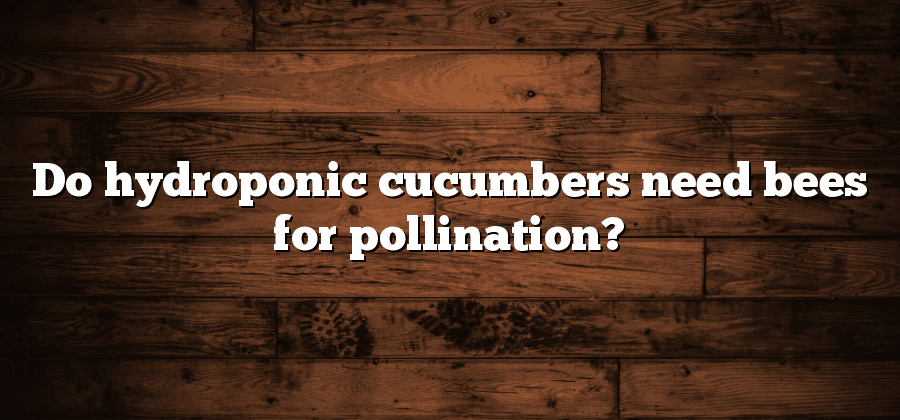Understanding the Pollination Process
Pollination is a crucial process in the reproductive cycle of plants, serving as a catalyst for the production of fruits, vegetables, and seeds. It involves the transfer of pollen from the male reproductive organ (stamen) to the female reproductive organ (pistil) of a flower. While some plants are self-pollinating, meaning they can fertilize themselves, others rely on external agents like wind, water, or animals to move pollen between flowers. This intricate mechanism ensures the genetic diversity and survival of plant species, making it a vital and fascinating aspect of plant biology.
Plants have evolved various strategies to attract pollinators, such as producing vibrant flowers, releasing sweet nectar, or emitting enticing fragrances. In the case of cucumber plants, their bright yellow flowers are incredibly attractive to bees, butterflies, and other insects. These pollinators unknowingly pick up the pollen grains while feeding on the nectar or searching for food on the flower’s surface. As they move from one cucumber flower to another, they unintentionally transfer the pollen to the receptive female pistil, enabling fertilization and subsequent fruit development. Such intricate and symbiotic relationships between plants and their pollinators play a critical role in maintaining ecosystem balance and food production.
The Significance of Pollination for Cucumber Growth
Pollination is a vital process for the growth and development of cucumbers. Without proper pollination, cucumber plants struggle to produce fruits, resulting in low yields and poor quality crops. This makes the understanding of pollination significant for cucumber growers.
One of the main reasons why pollination is crucial for cucumber growth is that it allows for the transfer of pollen from the male flower to the female flower. This transfer of pollen is required for fertilization to occur, leading to the formation of the cucumber fruit. The male flowers produce the pollen, while the female flowers contain the ovules that can develop into cucumbers. The process of pollination ensures that the pollen reaches the female flowers, triggering the fertilization process and the subsequent growth of the fruit.
Moreover, proper pollination also plays a role in determining the size, shape, and quality of cucumbers. When pollination is successful, each seed within the cucumber fruit develops, resulting in a plump and well-formed vegetable. Insufficient pollination, on the other hand, can lead to misshapen or undersized cucumbers. Additionally, incomplete pollination can cause certain portions of the fruit to remain undeveloped, resulting in irregular growth patterns. Therefore, understanding the significance of pollination is crucial for cucumber growers to ensure optimal crop quality and yield.
Examining the Hydroponic Cultivation Method
Hydroponic cultivation is a modern and innovative method of growing plants, including cucumbers, without the use of soil. Instead, plants are grown in water-based nutrient solutions, offering a controlled and stable environment for optimal growth. This cultivation method is gaining popularity due to its numerous advantages and potential for high crop yields.
One of the key benefits of hydroponic cultivation is the ability to provide plants with a precise and balanced nutrient intake. Nutrients can be carefully measured and adjusted to meet the specific needs of cucumber plants, ensuring they receive the essential elements for healthy growth. This level of control allows for better nutrient absorption and utilization, resulting in improved plant health and productivity. Additionally, the absence of soil eliminates the risk of certain diseases and pests commonly associated with traditional soil-based cultivation.
The Role of Bees in Natural Cucumber Pollination
Cucumbers, like many other plants, rely on pollination to reproduce and produce fruit. While some plants are self-pollinating and can reproduce without the help of external agents, cucumbers require the assistance of pollinators such as bees. Bees play a crucial role in natural cucumber pollination by transferring pollen from the male flowers to the female flowers, enabling fertilization and fruit development.
The process of cucumber pollination begins when male flowers produce pollen grains. Bees are attracted to the vibrant yellow color and nectar produced by these flowers. As bees collect nectar, the pollen grains stick to their fuzzy bodies. When the bees visit female flowers in search of more nectar, the pollen on their bodies rubs off onto the receptive stigma of the female flower. This transfer of pollen stimulates the fertilization process, leading to the formation of seeds and the development of cucumbers. Without the presence of bees, natural cucumber pollination would be significantly hindered, resulting in reduced fruit yield and quality.
Challenges of Pollination in Hydroponic Systems
Hydroponic systems have revolutionized the way crops are grown, providing a controlled environment for optimal growth. However, one of the major challenges faced in hydroponic cultivation is pollination. Unlike traditional farming methods that rely on natural pollinators such as bees and insects, hydroponic systems lack the presence of these crucial agents of pollination.
The absence of bees and other pollinators in hydroponic systems means that the transfer of pollen from the male to the female flowers needs to be facilitated artificially. This poses a significant challenge for hydroponic farmers, as they have to find effective ways to ensure successful pollination. Without pollination, the production of fruits and vegetables, including cucumbers, is severely compromised. As a result, hydroponic farmers are constantly seeking innovative techniques to overcome this challenge and secure a steady and reliable pollination process for their crops.






